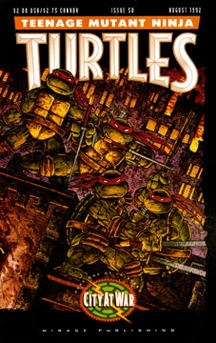It’s not fair to assume that the creator of something is also the best at telling stories about that something. Not all of the elite “Star Wars” stories are by George Lucas, not all of the best “X-Files” stories are from Chris Carter, etc. That having been said … all of the best “TMNT” stories – particularly as it pertains to my review of Mirage “Teenage Mutant Ninja Turtles” Volume 1 — are by Kevin Eastman and Peter Laird.
Certainly, there were other talents at Mirage – and Jim Lawson deserves a ton of credit for being the “City at War” co-scripter and penciller on Issues 51-62. But when E&L delivered Issue 50 on their own, I said to myself: “Now THIS is what TMNT is supposed to look and feel like.”
Together one last time
The E&L “feel” – a detailed cityscape that can be simultaneously beautiful and foreboding, and the way a sequence of panels can tell a story without dialogue – hits a reader like a sledgehammer (a refreshing sledgehammer) in Issue 50. (It’s the first all-E&L issue since No. 11, and unfortunately, it would turn out to be their last team-up.) In fact, this issue does not have any dialogue from characters. The only words come from a TV set blaring about the 1992 war in Bosnia.

“Teenage Mutant Ninja Turtles” Issues 50-62 (1992-93)
Titles: “City at War, Parts 1-13”
Writers: Kevin Eastman, Peter Laird, Jim Lawson
Pencils: Kevin Eastman, Peter Laird, Jim Lawson
Inks: Kevin Eastman, Peter Laird, Keith Aiken, Matt Banning, Jason Temujin Minor, Eric Talbot
We see the Turtles boarding up the windows at the Northampton farm, April flying to her sister’s place in L.A., Casey driving aimlessly out west, Splinter meditating in the woods, and rival factions of the Foot Clan killing each other in New York City.
The Turtles settle in sort of a hut on stilts in NYC (it’s called a water tower in the text, but there’s no water involved). The setting is clearly cold and drafty – even a sewer cavern would seem cozier — and it’s wonderfully evocative, both in E&L’s issue and when Lawson takes over for the remaining dozen.
Slow burn, brisk read
It should be noted that while “City at War” is 13 issues long and often cited as the biggest epic in Mirage “TMNT” up to this point, it’s actually not a significantly bigger story than the first return of Shredder or “Return to New York,” and it’s a surprisingly brisk read.
Aside from the full 40-page treatment given to Issue 50, the other issues are shorter, sometimes as few as 20 pages. And there are four major story threads (whereas the return of the Shredder and “Return to New York” had one thread, with April, Casey and Splinter absent from the latter saga).

A cynic would say “City at War” is padded, but I like the slow burn of following the journeys of April, Casey and Splinter that – it becomes readily apparent – won’t have anything to do with the Turtles’ dealings with the Foot Clan in the city. Plus, we also follow an old man in a hospital whose activities consist of watching depressing news reports about war. So don’t expect more story from “City at War” compared to previous sagas, just expect a deeper, moodier, more indie-film-style story.
“City at War” gives the non-Turtle characters their due – arguably even more so than the Turtles themselves — as April tries to live the SoCal life with her more outgoing sister, Robyn, only to realize that she belongs in NYC. Casey is forced to grow up rather dramatically when he finds himself the father of a newborn girl (Shadow) after a beautifully told rapid-fire romance with Colorado waitress Gabrielle.
I would argue that the writers earn the coincidence of Casey and April running across each other again in Issue 61; their immediate embrace illustrates that all they had been through separately is what brought them back together. It’s a clever alternative to a traditional romance yarn.
(Also, I absolutely love that April tells Splinter she sees him as a father figure in Issue 62; it’s almost worthy of tears when Splinter says “Daughter” and they hug. Arguably, the writers did very little to earn this moment other than April and Splinter’s tiff in “Shades of Gray,” yet it’s a perfect capper to Volume 1 that underscores the makeshift-family theme dating back to Issue 1.)
Spiritual journey for Splinter
Meanwhile, a spiritually and physically wandering Splinter breaks his leg falling from the same Northampton (or another Massachusetts factory town?) columnar building the Rat King falls from in “Tales” 4. The Rat King taunts Splinter as the ninja master recovers (only after eating rats for sustenance), and we ultimately learn the Rat King had been dead all along and Splinter was talking with his ghost.
“City at War” – despite being co-scripted by Laird, who is often credited with a lot of the wilder stuff in the “TMNT”-verse — wisely skips space aliens, superheroes and time travel. But it does retain the spiritual element (first introduced when Splinter swaps bodies with an old Japanese guy in Issue 9) in Splinter’s arc, and finds a wonderful use for the Rat King despite the entirety of his (living) arc being told in “Tales” 4.
Much-needed new villains
Arguably the saga’s biggest need at this point was a new overarching villain. Karai is probably the most major character in the “TMNT” franchise to be introduced this late in the game (the Turtles first talk to her in Issue 57, which came out in March 1993, the same month that the third “TMNT” movie signaled the end of the saga’s peak years). As the leader of the Japanese Foot Clan who is looking to clean up the NYC mess left in the wake of the Shredder’s death, she’s a solid character.
But is she really a villain in “City at War?” Strictly speaking, it’s the Shredder’s Elite Guard (the “TMNT”-verse’s equivalent to the Emperor’s crimson guards in “Star Wars”) who the Turtles fight in “City at War.” Our heroes actually team up with Karai because she promises she’ll leave the Turtles alone after the war is over; they can be out of the Shredder’s shadow for good.
However, that sequence in Issue 58 is suspicious as hell: The Turtles come upon Karai’s headquarters and see that the Shredder Elite have wiped out a ton of Foot soldiers, plus Karai’s non-combatant daughter. That firmly secures the Turtles’ place on Karai’s side in “City at War,” but it also seems so convenient for Karai. Could she pop up as a villain in future “TMNT” volumes?
A mature team
While “City at War” isn’t a great showcase for the individual Turtles’ character growth, they at least are shown to be a mature team. They are 20 or 21 years old in this story, which covers a year’s time. (Weirdly, the Mirage response to a letter inquiring about the Turtles’ ages asserts that they are 16 in “City at War,” and that only one year passed between “Return to New York” and “City at War.”
A few issues later, another letter-writer calls them out on that nonsense, correctly citing examples of time passing in the saga, from the newspaper in “Return to New York,” to the Shredder saying in “Return to New York” that three years passed between his battles with the Turtles, to a wall calendar and Bosnia references in “City at War.” Mirage didn’t respond to the argument.)
Raph is still Raph – the most gung-ho, “let’s kick some butt” member of the team — but he doesn’t throw Leo through a wall or anything. The best “team meeting” comes in Issue 58. Leo notes that, through the years, the Foot have largely been on the offensive against the Turtles (indeed, the Shredder Elite’s goal is to kill Leo, who had slain the Shredder).
A notable exception is Issue 1, which Mike correctly points out was a case of the Turtles fighting Splinter’s war. (In one example of the excellent dialogue in “City at War,” Leo says: “I would gladly die for [Splinter] … but … I don’t know if I can give him my life.”)
So this idea of going to NYC and taking on the Foot presents a new moral conundrum for the Turtles, like when the U.S. army gets involved in ongoing wars elsewhere on the globe. Leo provides some pearls of wisdom in Issue 53, after he and his brothers flee from a skirmish involving various Foot factions, the police and innocent bystanders. (In a particularly grim bit of humor, a guy with a Carpe Diem T-shirt is shown to be a casualty.)
A bigger statement?
“We were just … fuel for the fire … We just helped to escalate the conflict … to get people killed,” Leo says. Combined with the Sarajevo war reporting motif that runs through “City at War,” I wonder if Eastman, Laird and Lawson were attempting to make a comment on U.S. intervention in foreign wars. It’s probably a stretch to say that the writers intended any wider political statement; however, the simple fact that it comes to my mind shows what a rich, layered text “City at War” is.
It’s tough to say whether it’s my favorite “TMNT” saga, as the return of Shredder and “Return to New York” are classics, but without question it’s the most carefully thought-out, mature piece of writing delivered in Mirage Volume 1. What a heckuva way to go out … and to keep fans dialed in for Volume 2, which would launch in full color two months later.
P.S.: For a more in-depth look at each issue of “City at War” – and all “TMNT” comics, for that matter — I suggest checking out TMNT Entity. Reviewer Mark Pellegrini does a great job of delving into various themes and story points and how they tie together all of Volume 1, such as Casey’s obsession with his Chevy (a Rick Veitch contribution in “The River” and “Sky Highway”) and the Splinter/Rat King scenes having elements of Rick McCollum and Bill Anderson’s “reptiles vs. mammals” exploration in “Twilight of the Ring.”

